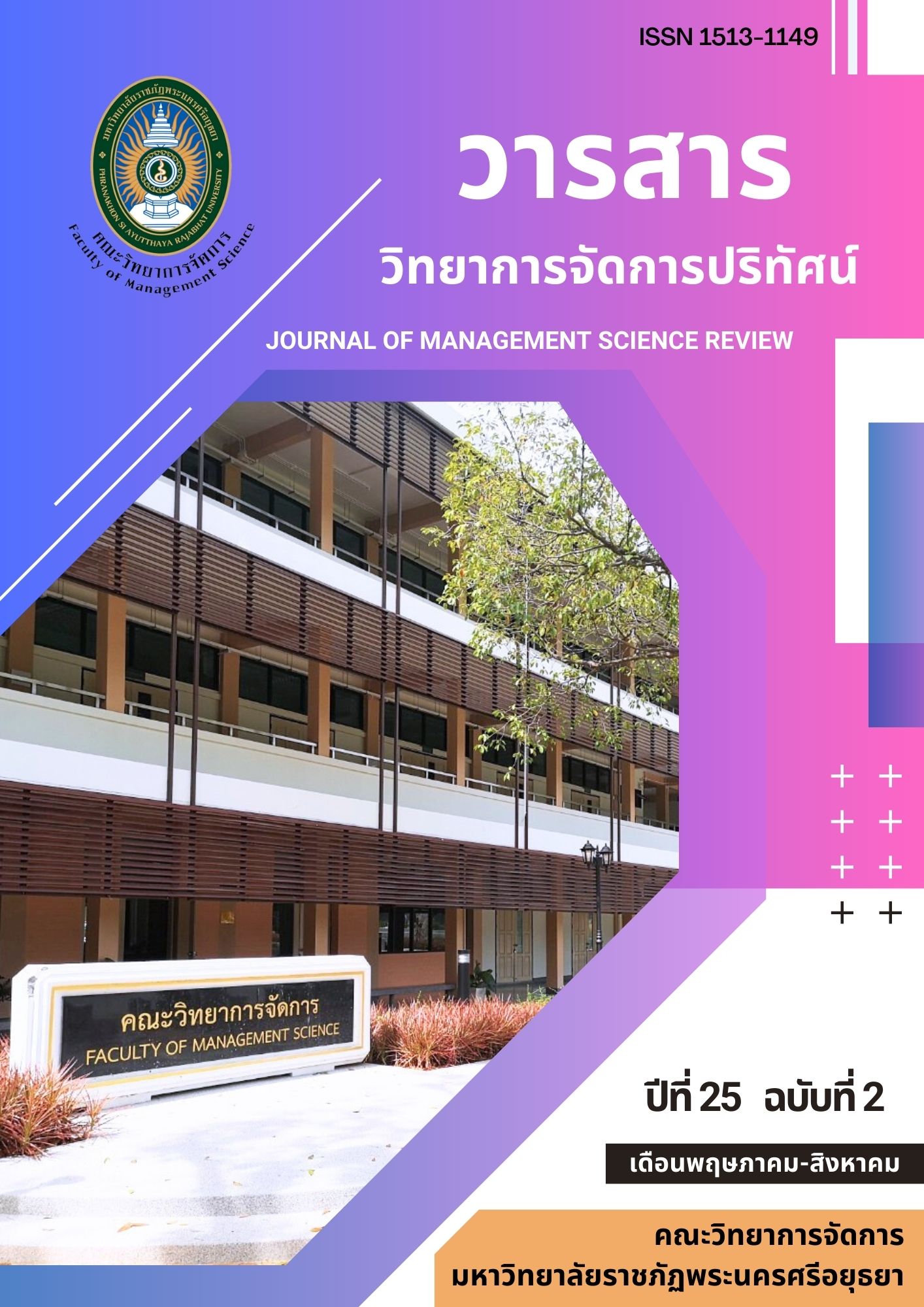Guidelines for The Development of Community Participation in Running Event in The New Normal : A case study of Chombueng Marathon, Ratchaburi Province
Keywords:
Community Participation, New Normal Running Events, Chombueng MarathonAbstract
The objectives of this research were (1) to study the current condition of community participation, problems, and threats to community participation in Chombueng Marathon; (2) to analyze factors of community participation in Chombueng Marathon as the new normal running activities; and (3) to propose the guidelines for the development of community participation in Chombueng Marathon as the new normal running activities. This research used Mixed Methods between quantitative and qualitative research methodologies. The quantitative data were collected from sample groups of people who were living in communities in the research area, consisting of 4 local administrative organizations with 3 Tambons, 14 villages, and 15 schools, and who participated directly in organizing of Chombueng Marathon. The 329 samples were drawn from convenience random sampling. Questionnaires were used to collect the data, along with participant observation. The data were analyzed by using frequency, percentage, mean, and standard deviation. The qualitative data were collected from 35 key informants who were drawn from purposive sampling, an in-depth interview, participatory observation, and focus group were used to collect the data, which was analyzed by content analysis. The findings were as follows:
- 1.The current condition for organizing the Chombueng Marathon is the cooperation of Muban Chombueng Rajabhat (MCRU) and network partners with local communities. The motto of this event was “Local running activity with international standards.” The event was held in the third week of January Annually, the nature of participation is the relationship as co-host, and there were managerial administrations allowing communities to participate in activities at the event with small meetings and large meetings and demonstrations. The problems and threats to community participation in the Chombueng Marathon were found to have the following key points; (1) the lack of a real clear policy of MCRU for running activities and organizing created a delay in operating procedures and coordination with the community; (2) the lacking of supporting resources delayed delivery; and (3) the inconsistent communication and public relations created delayed information.
- 2.Key factors for community participation in the Chombueng Marathon as new normal running activities in total were of the highest level of importance. When considering in topic scoring from highest to lowest was as follows; (1) the realization of people in the community; (2) the roles of community leaders; (3) the compensations and benefits; (4) the communication and public relations; and (5) the policies of the organization.
3. The guidelines for the development of community participation in the Chombueng Marathon as a new normal running activity consisted of 5 main guidelines that will be integrated with Chombueng Marathon organizing in order to create sustainability through community participation as follows; (1) building the realization of people in the community (2) fostering the leadership roles of community leaders; (3) sharing of compensation and benefit; (4) the development of communication and public relations; and (5) the policy formulation of the leading organization (MCRU).
References
กิตติภัฏ ฐิโณทัย. (2562). ปัจจัยที่มีอิทธิพลต่อการมีส่วนร่วมของประชาชนในพื้นที่ที่ก่อให้เกิดความสำเร็จของการท่องเที่ยวโดยชุมชน : กรณีศึกษาชุมชนบ้านบางน้ำผึ้ง จังหวัดสมุทรปราการ. วิทยานิพนธ์รัฐประศาสนศาสตรมหบัณฑิต สาขารัฐประศาสนศาสตร์, สถาบันบัณฑิตพัฒนบริหารศาสตร์.
ไกรศร วันละ และยุภาพร ยุภาศ. (2565). การมีส่วนร่วมของประชาชนในการพัฒนาชุมชนอย่างยั่งยืน. วาสารการบริหารนิติบุคคลและนวัตกรรมท้องถิ่น. 8(2), 391-404.
คณะกรรมการวางแผนและขับเคลื่อนโครงการจอมบึงมาราธอน. (2565, 1 พฤศจิกายน). คณะกรรมการวางแผนและขับเคลื่อนโครงการจอมบึงมาราธอน มหาวิทยาลัยราชภัฏหมู่บ้านจอมบึง จังหวัดราชบุรี, สัมภาษณ์.
ณรงค์ เทียมเมฆ. (2565, 20 มกราคม). ผู้ทรงคุณวุฒิสำนักงานกองทุนสนับสนุนการสร้างเสริมสุขภาพ (สสส.), สัมภาษณ์
ถวิลวดี บุรีกุล. (2552). การมีส่วนร่วม แนวคิด ทฤษฎีและกระบวนการ. (พิมพ์ครั้งที่ 4). กรุงเทพฯ: ส.เจริญการพิมพ์.
ธงชัย คล้ายแสง, บุญทัน ดอกไธสง และนัยนา เกิดวิชัย. (2562). การพัฒนาการท่องเที่ยวเชิงกีฬาโดยการบูรณาการหลักพุทธธรรมของจังหวัดบุรีรัมย์. บัณฑิตศึกษามหาจุฬาขอนแก่น, 6(4), 823-840.
นงลักษณ์ เพิ่มชาติ และเสรี เพิ่มชาติ. (2564). คู่มือการบริหารจัดการความร่วมมือภาคประชาสังคมในการจัดงานวิ่งระดับชุมชน. หน่วยบริหารและจัดการทุนด้านการเพิ่มความสามารถในการแข่งขันของประเทศ (บพข.)
บุญชม ศรีสะอาด. (2560). การวิจัยเบื้องต้น. (พิมพ์ครั้งที่ 10). กรุงเทพฯ: สุวีริยาสาส์น.
ปิยะธิดา ปาลรังสี. (2557). ปัจจัยที่ส่งผลต่อการมีส่วนร่วมของประชาชนในการท่องเที่ยวโดยชุมชนอำเภอขนอม จังหวัดนครศรีธรรมราช. วิทยาศาสตรมหาบัณฑิต สาขาวิทยาศาสตร์การกีฬา, จุฬาลงกรณ์มหาวิทยาลัย.
รัฐ จิโรจน์วณิชชากร. (2564, 8 พฤศจิกายน). ผู้บริหารสมาคมการค้าผู้จัดงานกีฬามวลชนไทย (Thai Mass Participation Sports Trade Association : TMPSA), สัมภาษณ์.
วิ่งไหนดี. (2561). อันดับงานวิ่งประจำปี 2561. ค้นเมื่อ 7 ตุลาคม 2564, จาก
http://www.wingnaidee.com/ranking/allevents2018/.
สมจินตนา คุ้มภัย. (2559, พฤษภาคม–สิงหาคม). ปัจจัยที่มีผลต่อการมีส่วนร่วมของชาวชุมชนในองค์การบริหารส่วนตำบลต้นแบบที่บูรณาการแผนชุมชนสู่แผนพัฒนาท้องถิ่น จังหวัดนครศรีธรรมราช. Veridian E-Journal SU, 9(2), 733-748.
สัจจา ไกรศรรัตน์ และคนอื่น ๆ. (2564). การพัฒนาการจัดการโซ่อุปทานการท่องเที่ยวเชิงกีฬาเพื่อพัฒนาเศรษฐกิจชุมชนด้วยกิจกรรมการวิ่งบนฐานวัฒนธรรมท้องถิ่น. หน่วยบริหารและจัดการทุนด้านการเพิ่มความสามารถในการแข่งขันของประเทศ (บพข.).
สันติ พัฒน์พันธุ์. (2562, กันยายน-ธันวาคม). การมีส่วนร่วมของประชาสังคมในการบริหารการท่องเที่ยวเชิงวัฒนธรรมโดยใช้ภูมิปัญญาท้องถิ่น. Journal of Administrative and Management, 7(3), 1-11.
สำนักงานกองทุนสนับสนุนการสร้างเสริมสุขภาพ. (2563). คู่มือจัดการแข่งขันวิ่งบนถนน และมาตรการจัดการแข่งขันภายใต้การแพร่ระบาด COVID-19. ค้นเมื่อ 31 ตุลาคม 2563, จาก https://www.thaihealth.or.th.
Arnstein, Sherry R. (1969, July,). A Ladder of Citizen Participation. Journal of the American Planning Association, 35 (1969), 216-224.
Blomgren , L. B. & O’Leary, R., (2008). Big Ideas in Collaborative Public Management. New York: Routledge.
Department Sport and Recreation South Africa. (2012). National Sport Tourism Strategy. First Draft, Sport and Recreation South Africa, Republic of South Africa.
Kyriaki, K. (2006). The Impact of Sport Tourism Event Image on Destination Image And Intentions to Travel : a Structural Equation Modeling Analysis. Doctor of Philosophy Department of Park, Recreation and Tourism Resources Michigan State University.
Penang Marathon. (2009). How A Marathon Boosts the Penang Tourism Industry, Press Statement by YB Danny Law Heng Kiang Chairman of The Penang Bridge International Marathon Dated 16th August 2009, Penang Malaysia.
Talo`, C., Mannarini, T. & Rochira, A. (2014). Sense of Community and Community Participation: A Meta-Analytic Review. Social Indicators Research, 117(1), 1–28. https://doi.org/10.1007/s11205-013-0347-2
Wollabaek, D., & Selle, P. (2003). Participation and Social Capital Formation: Norway in a Comparative Perspective. Scandinavian Political Studies, 26(1), 67–91.




